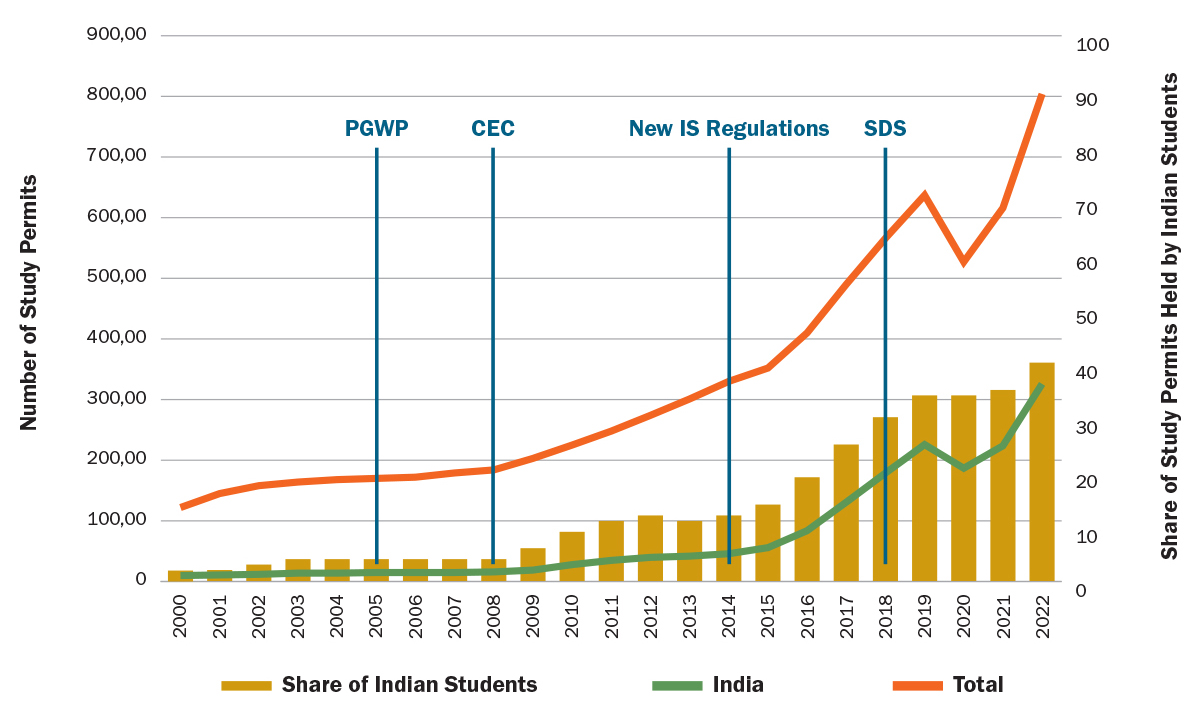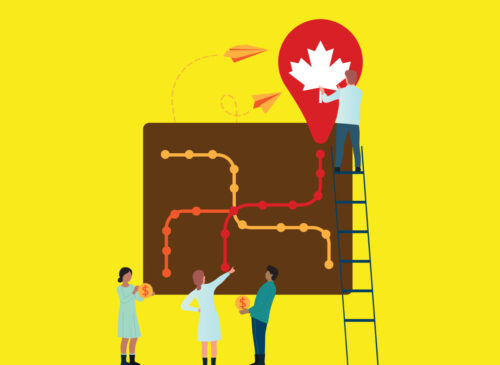Anukriti Randev, an international student, and Kriti Sharma, a new permanent resident turned domestic student, set out to learn how and why students from the Punjab region of India are coming to Canada—and the myths and realities they encounter along the way.

The Contemporary Influx of Students from Punjab to Canada
The flow of students from India to Canada over the last decade has been unprecedented. In 2022, India surpassed China as the leading origin country for international students in Canada, with roughly 40 percent of the study permits in Canada held by Indian-origin students. One region in India, Punjab, dominates discussions on student migration to Canada. This distinction became more prominent recently, when nearly 700 Indian international students, (most of whom were from Punjab) feared deportation from Canada due to fraudulent admission letters.
Both of us are a part of this influx—or so we thought. We came to Canada in 2022; one of us was an international student, and the other was a new permanent resident. We were both pursuing studies at a world-class university and wanted to gain exposure to international education and skills development through our master’s programs. We knew the numbers, but they did not reflect what we saw at our university. Instead, we saw the statistics reflected in young Punjabi students over-represented at restaurants waiting tables, at our apartment building’s security office, at the mall behind counters, and at several small private colleges—the so-called diploma mills of Canada.
The data corroborated what we saw. As per a StatsCan study, the recent growth in the share of international students from India at the college level has been notable. From 2000 to 2004, four per cent of international students came from India. But by the 2015-to-2019 period, India was the number one source country, making up 67 per cent of international students intending to study at the college level (for non-university postsecondary programs), against the 21.3 per cent of Indian-origin students intending to study in university programs. Concurrently, the labour market participation of international students studying at the college level has increased markedly from seven per cent in 2000 to 57 per cent in 2018.
Thanks to a common course, we crossed paths and talked about our observations regarding Punjabi students. The similarity in our observations prompted us to engage with Punjabi students around us. We learned of their trials and tribulations but most of all their aspirations to stay in Canada. The more we observed, the more interested we grew in situating our observations within the broader context of the migration-education-work dynamics in Canada. But the origin of our interest went further back in time.
An Attempt to Understand the Numbers
Both of us had slightly different journeys leading us to Canada, yet our shared aspiration was to migrate for educational pursuits. For one of us, the master’s program was to be a launchpad for a career in human rights advocacy, and for the other, a stepping stone to a Ph.D. As we navigated the customary university application procedure, seeking guidance from agents, we couldn’t help but notice the extensive network of intermediaries firmly established in Punjab. This network framed Canada not just as a study destination, but primarily as an immigration destination. Agents often pitched to aspirants the promise of citizenship or permanent residency following a small stint at some diploma mill. Surprisingly absent from these conversations was any emphasis on the particular field of study or career aspirations—a stark contrast to the conventional discourse surrounding higher education decisions.
From our observations in India and then in Canada, it quickly became clear to us that the narrative of Punjabi youth migrating to Canada goes beyond the stereotypical tale of upper-class and upper-middle-class students in pursuit of a global education experience. It encapsulates the aspirations of almost every Punjabi youth, irrespective of financial standing, longing to reach Canada. But the question remains: What precisely fuels this desire?
But the question remains: What precisely fuels this desire?
We discussed this with our professor, Ito Peng, Professor of Sociology and Public Policy, and Canada Research Chair in Global Social Policy at University of Toronto, and she encouraged us to dig deeper. With that motivation, we applied for, and secured a research funding from the Asian Institute at U of T. And thus, we set out to unpack the story of the Punjabi youth aspiring to study in Canada. We conducted a month-long ethnographic fieldwork study in May 2023 in Punjab, talking to 34 aspirants between the ages of 18 and 27 years. Our field site was Jalandhar district in the Doaba region and Ropar district in the Malwa region of Punjab. While the Doaba region has been the epicenter of emigration in Punjab since the 1900s when early emigrants from Jalandhar (then Jullundur) and Hoshiarpur (another Doaba district) became the first South Asians to immigrate to Canada, the Malwa region is also witnessing an extraordinary rise in its youth emigration.
The interviews were semi-structured, lasted from 30 to 45 minutes, and included questions regarding factors influencing students’ decision-making in choosing to study in Canada. The idea was to elicit narratives that provided insights into the multifaceted aspects shaping their choices, ranging from personal motivations to external influences.
For Immigration or Education? Situating Priorities of Punjabi Youth
Our initial examination of the data suggests that the migration of Punjabi youth to Canada is not purely academic. Of the various intriguing facets we uncovered, this article will specifically delve into the most dominant aspiration within our sample: the desire for immigration, often synonymous with the pursuit of a better life, seen as impossible in Punjab or possible only in Canada.
Our interviews revealed that Punjabi students aspiring for Canadian education can most accurately be identified as pre-migrants pursuing long-term settlement through education. We observed a clear blurring of the line that separates “migration for education” and “education for migration” in the case of our sample. The majority of our interviewees (31 out of 34) answered in the negative when we inquired about their plans to return to India after the completion of their studies, highlighting the primacy of immigration as an implicit aspiration behind the move to Canada. Consider these responses to the question: Do you plan to return to India after the completion of your studies?
21-year-old female aspirant: No. What will I do in India? I will call my mother and sister to Canada once I am settled. I will live here [in Canada].
18-year-old male aspirant: No, if I get better job opportunities there [in Canada], I would not want to come back.
Clearly, international student mobility in our sample of Punjabi students was dominated by “education for migration.” This observation aligns with broader trends, as indicated by the 2021 Canadian Bureau for International Education (CBIE) International Student Survey, where a substantial 43.3 per cent of international students in Canada expressed their intention to apply for permanent residency following three years of work experience in the country. In contrast, a mere 18.8 per cent articulated a plan to return to their home country after three years, with the potential consideration of coming back to Canada at a later time.
While the concept of pursuing education as a pathway to migration was something we both contemplated before delving into our research, we were taken aback by the sheer complexity of the whole situation. The mobility of Punjabi students to Canada is a multifaceted phenomenon, driven by a multitude of overlapping aspirations and mediated by a complex infrastructure comprising various actors (state as well as non-state actors like third-party recruitment agents), networks (including networks of friends and family abroad), and technologies (social media and the internet).
Examining the Canadian Policy Context
Persistent aspirations are supported by corresponding opportunities. In the realm of students’ education-cum-immigration aspirations, Canada’s immigration policy stands out as a pivotal and defining opportunity. The surge in international students in Canada can be attributed to governmental initiatives focused on actively recruiting students from abroad, leveraging the strategic promise of citizenship.
The introduction of varied fees for international students in the 1970s, coupled with budget cuts to postsecondary educational institutions until the early 2000s, gave rise to an interdependent ecosystem. Within this context, the federal government responded by implementing and expanding supportive policies and strategic plans, aiming to bolster international student recruitment. Simultaneously, educational institutions explored avenues to boost enrolment by attracting students subject to differential fees.
In 2001, the Canadian federal government initiated a crucial overhaul of its immigration policy by replacing the 1976 Immigration Act with the Immigration and Refugee Protection Act. They redefined studying in Canada as the inaugural step towards possible citizenship by introducing different pathways to citizenship, including the Canadian Experience Class (CEC) and the Provincial Nominee Program.
This strategic shift aimed to concurrently address the immediate recruitment needs of universities and colleges while recognizing the long-term potential of students as ideal immigrants. By 2012, international education became the most valuable export from Canada and the government responded by further encouragement to bring in more students. The federal government released its plan with detailed targets to double the number of international students by 2022 as part of the plan to include post-secondary education in Canada’s economic policy regime.
The Student Direct Stream (SDS) facilitated a swift processing time of just 20 days upon the submission of all required documents for study permit applications. After finishing their studies, students under this program became eligible for a post-graduation work permit, enabling them to acquire valuable work experience. This experience, in turn, contributed to their eligibility to apply for permanent residency through various immigration pathways and programs. Consequently, these students had the opportunity to transition from temporary foreign workers to economic immigrants through a two-step immigration selection process.
Figure 1: Number of Study Permit holders in Canada 2000-2022

Source: Immigration, Refugees and Citizenship Canada, Study permit holders on December 31st by province/territory of intended destination and study level. Note: The post-graduate work permit program (PGWPP) was introduced in the mid-2000s, the uncapped Canadian Experience Class (CEC) in 2008, new regulations for international student (IS) in 2014 that automatically authorized the study permit holders to work off-campus for up to 20 hours per week during the academic session and full-time during scheduled breaks without the need to apply for a separate work permit, and the Student Direct Stream (SDS) in 2018.
Students in our sample were cognizant of these policies, in part due to recruitment agents that have been promising a study route to citizenship for years, and in part due to a “culture of migration” in Punjab that has made the state so saturated by ideas, practices, and stories of the “student-turned-immigrant” that many young people in Punjab expect to live and work in Canada.
20-year-old aspirant: There are options of PR which is difficult in other countries like Australia and even England. I know a relative who has been in Australia for so long but is till now not [a] permanent [resident].
The collective impact of these policies and programs is evident in the overall success in attracting an impressive number of Indian students in the last decade (Figure 1). Despite a notable decrease in study permit applications from India amid diplomatic issues, the issuance of over 215,910 study permits to Indian students until November 2023 maintained India’s position as the primary source of international students last year.
The Restrictive Policy Turn
Another critical piece in this story is the retrenchment of the Canadian state from funding of educational institutions, which made the latter over-reliant and often greedy for international tuition. If acceptance into a one-year program at a community college became a pathway to citizenship for Punjabi students, Canadian community colleges also exploited this trend extensively, building new campuses, enrolling more and more students and rolling out programs that promised little in terms of career advancement. In a bid to preserve the integrity of the international education system and relieve some pressure on housing, healthcare, and other services, federal government finally decided to intervene, taking a sudden quantum leap towards restrictive regulations in early 2024.
The first change involved doubling the minimum financial requirement for international students from $10,000 to $20,635 CAD, exclusive of tuition and any additional fees for accompanying family members. This may seem restrictive, but a closer examination reveals a more nuanced picture. The previous $10,000 CAD requirement, in addition to tuition, seemed disproportionately burdensome for those from humble backgrounds. Our interviews, however, confirmed the financial resiliency of students from Punjab. Despite the considerable expenses associated with international education, respondents (including those with limited economic means) expressed a strong commitment to invest substantial amounts, such as $40,000 CAD annually, in their education and living expenses in Canada.
It’s clear from our research that doubling the financial requirement may dissuade some prospective students, but not all. Instead, the change is more likely to put more financial pressure on families to send their children to Canada. This translates into students taking on low-skilled, low-wage work to offset high tuition, living expenses, and paying off the family debt.
Instead, the change is more likely to put more financial pressure on families to send their children to Canada.
The second change was the creation of a cap on study permits given out to international students for postsecondary studies. This new policy could significantly restrict student mobility from Punjab to Canada, in part because the cap is selectively applied to non-master’s programs, such as college diplomas, where Punjabi students are overrepresented.
Thirdly, changes to work permit accessibility for students and their families were also introduced. Starting September 1, 2024, postgraduate work permits (PGWP) will no longer be available for students in public college-private institution models. Furthermore, the Canadian government has specified that open work permits for spouses of international students will be limited, with eligibility extended only to spouses of graduate or professional students. Returning to our earlier discussion on immigration aspirations and the reliance on securing employment after completing studies through the two-step immigration pathway, the restricted availability of PGWP could significantly hamper the aspirations and opportunities of Punjabi youth.
The true implications of these changes can be known only in time; however the long-term outlook hints at both opportunities and challenges for Punjabi youth. In terms of opportunity, the changes to the education-migration pathway could generate a positive change for education in Punjab to meet students’ need for a strong educational background that would enable them to compete for admission to master’s or doctoral programs in leading Canadian universities. The increased financial requirement will present a considerable challenge for poor families in Punjab. Perhaps the most damaging possibility under this new landscape may be the attempts of youth, blinded by the Canadian dream, to resort to illegal modes to enter Canada (already established in relation to the United States), putting them even more at the mercy of unscrupulous agents in the system than before.
Looking Ahead
Canada, the land of opportunities, welcomes thousands of immigrants every year, with international students constituting a significant proportion of this diverse demographic.
Our objective is to untangle the mixed aspirations of students heading to Canada and situate them within the structures that motivate, facilitate, and constrain these aspirations.
As we analyze the empirical evidence we’ve gathered, our objective is to untangle the mixed aspirations of students heading to Canada and situate them within the structures that motivate, facilitate, and constrain these aspirations. The aim is to outline some key aspects of the student side of the international education story in Canada and connect it to the contemporary realities of a globalized world where education, migration, and work are increasingly interlinked. However, we understand that this study is limited in its scope. The journey of Punjabi youth may or may not be replicated elsewhere, and this is a question we aim to explore in the future.
As we wait out the impact of recent policy changes on the trajectories of Punjabi youth aspiring to study in Canada, it will be important to understand the nuanced motivations and aspirations of these youths beyond academic pursuits. In researching their aspirations through this study, we aim to mirror their desired future, and their relative autonomy and efficacy in shaping it.










